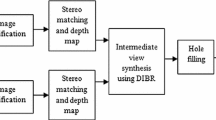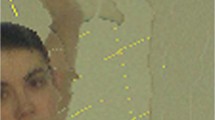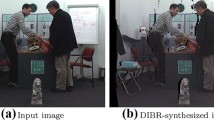Abstract
In view synthesis, pixels in an original view are warped into a virtual view with depth-image-based rendering (DIBR). During the procedure of DIBR, distortions in depth map may lead to geometric errors in the synthesized view which will induce quality degradation of synthesized view. Therefore, how to efficiently preserve the fidelity of depth information is extremely important. In this paper, we explore and develop a maximum tolerable depth distortion (MTDD) model to examine the allowable depth distortion which will not introduce any texture distortion for a rendered virtual view and accordingly develop. Experimental results show that a virtual view can be synthesized without introducing any geometric changes if depth distortions follow the MTDD specified thresholds.












Similar content being viewed by others
Change history
01 November 2017
The authors regret that the funding number “ZR2016FB20” was incorrectly written in the acknowledgement as “2016ZRB01AIU”.
References
Daribo I, Tillier C, Pesquet-Popescu B (2008) Adaptive wavelet coding of the depth map for stereoscopic view synthesis. In: Proc. IEEE 10th Workshop MSP, pp 413–417
Fang L, Cheung NM, Tian D, Vetro A, Sun HF, Au OC (2014) An analytical model for synthesis distortion estimation in 3D video. J IEEE Trans Image Process 23(1):185–199
Fang L, Xiang YJ, Cheung NM, Wu F (2016) Estimation of virtual view synthesis distortion toward virtual view position. J IEEE Trans Image Process 25(5):1961–1976
Federica B, Emilie B, Marco C, Patrick L, Simone P (2015) Objective image quality assessment of 3D synthesized views. J Signal Proc image Com 30(2015):78–88
Hannuksela M, Rusanovskyy D, Su W, Chen R, Li P, Aflaki P, Lan D, Joachimiak M, Li H, Gabbouj M (2013) Multi-view-video-plus-depth coding based on the advanced video coding standard. J IEEE Trans Image Proc 22(9):3449–3458
Lei J, Li S, Zhu C, Sun M, Hou C (2015) Depth coding based on depth-texture motion and structure similarities. J IEEE Trans Circuits Syst Video Technol 25(2):275–286
Liu YW, Huang QM, Ma SW, Zhao DB, Gao W (2009) Joint video/depth rate allocation for 3D video coding based on view synthesis distortion model. J Sign Process Image Communic 24(8):666–681
Loghman M, Kim J (2015) Segmentation-based view synthesis for multi-view video plus depth. J Multimedia Tools Appl 74(5):1611–1625
Mateusz G, Krzysztof W, Marek D (2008) View synthesis software and assessment of its performance. ISO/IEC JTC1/SC29/WG11 MPEG/M15672
McMillan L Jr (1997) An image-based approach to three-dimensional computer graphics. Ph.D. dissertation, University of North Carolina at Chapel Hill, Chapel Hill, NC Natural Science Foundation of Shandong Province
Merkle P, Smolic A, Mller K, Wiegand T (2007) Multi-view video plus depth representation and coding. In: Proc. IEEE Int. Conf. Image Process. (ICIP), I-201CI-204
Merkle P, Jaehwan J, Smolic A, Farin K, Muller P (2009) The effects of multiview depthvideo compression on multiview rendering. J Signal Proc Image Com 24(2009):73–88
Sanchez A, Shen G, Ortega A (2009) Edge-preserving depth-map coding using tree-based wavelets. In: Proc. 43rd Asilomar Conf. Signals, Syst. Proc. IEEE 10th Workshop MSP, pp 578–582
Shao F, Lin WS, Jiang GY, Yu M, Dai QH (2014) Depth map coding for view synthesis based on distortion analyses. J IEEE Journ Emerg Select Top Circuits Syst 4(1):106–117
Xu X, Po L, Ng K, Feng L, Cheung C, Cheung C (2013) Depth map misalignment correction and dilation for DIBR view synthesis. J Signal Proc Image Com 28(9):1023–1045
Yuan H, Kwong S, Liu J, Sun J (2014) A novel distortion model and Lagrangian multiplier for depth maps coding. J IEEE Trans Circuits Syst Video Technol 24(3):443–451
Zhang QW, An P, Zhang Y, Zhang ZY (2011) Efficient rendering distortion estimation for depth map compression. In: Proc. IEEE 18th ICIP, pp 1105–1108
Zhang Y, Kwong S, Hu S, Jay Kuo C-C (2014) Efficient Multiview depth coding optimization based on allowable depth distortion in view synthesis. IEEE Trans Image Process 23(11):4879–4892
Zhang Y, Kwong S, Hu SD, Jay Kuo CC (2014) Efficient Multiview depth coding optimization based on allowable depth distortion in view synthesis. J IEEE Trans Image Process 23(11):4879–4892
Zhao Y, Zhu C, Chen Z, Yu L (2011) Depth no-synthesis-error model for view synthesis in 3-D video. J IEEE Trans Image Proc 20(8):2221–2228
Acknowledgements
This work is supported by the National Natural Science Foundation of China under Grants 61471262, 61520106002 and 61601261, and by Ph.D. Programs Foundation of Ministry of Education of China under Grants 20110032110029 and 20130032110010, Doctoral Fund of Natural Science Foundation of Shandong Province under Grants 2016ZRB01AIU and a Smart Future Fellowship sponsored by the Queensland Government of Commonwealth Australia.
Author information
Authors and Affiliations
Corresponding author
Rights and permissions
About this article
Cite this article
Wang, L., Hou, C., Qi, S. et al. Analysis of maximum tolerant depth distortion in view synthesis. Multimed Tools Appl 77, 7909–7927 (2018). https://doi.org/10.1007/s11042-017-4690-1
Received:
Revised:
Accepted:
Published:
Issue Date:
DOI: https://doi.org/10.1007/s11042-017-4690-1




